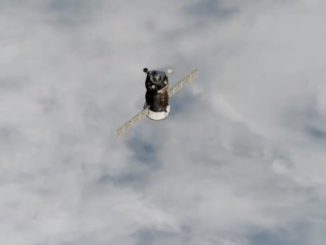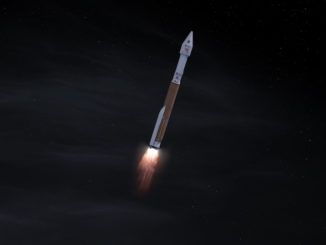
A spacecraft that helped bolster planetary defense is now at the end of its operational mission. On Thursday, engineers at NASA’s Jet Propulsion Laboratory in California sent the Near-Earth Object Wide-field Infrared Survey Explorer (WISE) spacecraft into its final hibernation mode by shutting off its transmitter.
The command, issued from the Earth Orbiting Missions Operations Center at JPL, brought to an end more than a decade of observations of comets and asteroids that helped further the understanding of celestial bodies that could potentially pose a threat to Earth.
NEOWISE reached its swan song because it doesn’t have a propulsion system and therefore wasn’t able to keep it in orbit. That, coupled with increased solar activity this year, meant the spacecraft will naturally lower in orbit until it burns up in the atmosphere in late 2024.
Dozens of people who were involved in the spacecraft’s mission throughout the years gathered at JPL to witness the moment and celebrate the years of science observations.
Today we bid farewell to NEOWISE and celebrated its fabulous team. The mission mapped the skies and boosted our nation’s planetary defense strategy, and its legacy will live on in NEO Surveyor (being built at @NASAJPL now!). Thanks for all the science! https://t.co/yRhqvLJ5sj pic.twitter.com/i3J5SCEtgv
— Laurie Leshin (@LaurieofMars) August 8, 2024
In the hours preceding the final spacecraft communications, Spaceflight Now spoke with Amy Mainzer, the principal investigator for NEOWISE at the University of California, Los Angeles. She joined the original WISE mission in 2003, but said the finale of NEOWISE wasn’t a sad moment for her.
“I feel great! No regrets. This telescope was supposed to last for seven months and it launched in 2009. It’s now 2024, so who could ask for anything more,” Mainzer said. “I mean, my gosh, we’ve had such a great run of it and we still have a ton of work to do. We’re going to be using these data for decades to come.
“I personally have a couple of papers we are just really trying to push out right now. So, we are super busy. There’s just a lot to be really happy about and so grateful for.”
That primary seven-month mission ended in 2010 after the spacecraft not only completed its original infrared survey around the Earth, but also because it ran out of its onboard coolant, which was necessary to allow for infrared observations.
NASA decided to rename the telescope “NEOWISE” that year and it completed its survey of the main belt asteroids. After that, it was put into hibernation in early 2011.
“[The cryogenics] lasted a bit longer than it was supposed to, which was great, but it was over pretty fast and we knew there was more we could do when it came to the asteroids in particular and the comets,” Mainzer said. “So, it was really painful to have to see it shut down the first time because we thought, ‘Ah, this is such a missed opportunity. We could do more.’ But we got a second chance and that was really great.”
That comeback moment came in 2013 when NEOWISE was brought out of hibernation under a program called the Near-Earth Object Observations Program. That overall mission is now under the purview of NASA’s Planetary Defense Coordination Office.
Over the next decade, NEOWISE detected more than 3,000 near-Earth objects, including 215, which were first registered by the spacecraft. The day that the final transmission was sent to NEOWISE, NASA shared its the final exposure taken Aug. 1, 2024, which shows part of the Fornax constellation.

Dawn of NEO Surveyor
With the conclusion of the NEOWISE program, NASA is moving on to its next phase of planetary defense with the forthcoming NEO Surveyor spacecraft. As she spoke with Spaceflight Now on Aug. 8, Mainzer was overlooking the cleanroom containing some pieces of the telescope.
A protective paneling for the telescope was being uncovered in the room below the viewing gallery as engineers elsewhere at JPL were working with the mirrors for the 50 centimeter (nearly 20 inch) diameter telescope.
Heading into NEO Surveyor development, Congress tasked NASA with the mandate of making “significant progress” towards finding “more than 90 percent of all NEOs larger than 140 meters in diameter.” Mainzer said that will take time.

“We expect that after the first five years, we will have found probably more than two-thirds of them. It will take us a little longer than that to get to the 90 percent mark. We think in about 10 years we will get there,” she said. “It takes a while because these objects are intrinsically faint. They’re small. They’re being seen at a great distance away. We do want to see them when they’re far away. We don’t want to wait until they’re right on top of us.
“But even so, it still takes a long time. It’s a hard problem. And after about 10 years, we think we will top out about 90 percent.”
During the gap between the end of NEOWISE and the launch of NEO Surveyor no earlier than September 2027, Mainzer says NASA will be relying on its ground-based assets in places like Hawaii and Arizona as well as from other global partners. Mainzer said she and her team will also be busy with data from NEOWISE provided until its last downlink.
“We’ll be analyzing the data from NEOWISE and looking to see if we happen to have incidental detections of some of the objects that got discovered or that will be discovered in the next few years,” she said.
With the launch of NEO Surveyor coming up in roughly three years at minimum, Mainzer said she and her team will be incredibly busy transitioning from one spacecraft to the next.
“We have a lot of work to do, but when we are done, and this launches, hopefully we’ll have a great new capability to see what’s out there in the Earth’s neighborhood,” Mainzer said. “It’s not going to be perfect, nothing ever is, but it’s going to really expand what we will know about the objects in our neighborhood. It will be part of a larger network of telescopes on the ground that will also help us fill in the gaps and really tell us what’s actually out there nearby.”




